By George F. Black, as told to Howard Dunbar
On March 19, 1945, the Essex-class carrier USS Franklin (CV-13), dubbed “Big Ben,” lay 50 miles off Honshu, one of Japan’s Home Islands. From her decks warplanes were taking off to attack targets on shore. In response, a lone Japanese plane attacked the Franklin with two bombs with deadly accuracy.
Hundreds of men aboard the carrier lost their lives (921 to be exact, and 254 wounded) in the ensuing explosions and fire, but through the heroic efforts of surviving members of her crew, she was kept afloat, earning the title “The Ship That Wouldn’t Die.” Two officers—Lieutenant Commander Joseph T. O’Callahan, one of the ship’s chaplains, and Lieutenant (j.g) Donald Gary—were awarded the Medal of Honor for their heroic efforts to save fellow crewmembers.
One of the crewmen forced to abandon ship was Radioman 3rd Class George Fain Black. This is his story.
“Rise and Shine”
“Up all hammocks—rise and shine—up all hammocks.” The resounding voice of the master-at-arms was followed by a punch of his truncheon to the bottom of my sack where my buttocks caused a blimp in the contour of my bedding. It was a sudden shock, which abruptly concluded a deep stupor. I had not had enough sleep; I had been relieved of an eight-hour watch at 2400, and my wristwatch showed that it was 0330.
I swung out and grabbed the line at the overhead hook, landing feet first. The mess cooks were pulling the mess tables from the bulkhead racks and were pulling the legs out into lock position when the truncheon struck again and the MAA announced, “Mess for the airedales, clear the mess hall.” [Airedales are crewmen working for an air group on an aircraft carrier who have “aviation” in their rating, e.g., aviation machinist mate. They were a different group than those crewmen who worked on the ship itself.]
We had recently left the U.S. Navy staging area at Ulithi Atoll in the South Pacific and were heading north. The tropical weather was changing. No longer were we in hot and humid compartments—it was getting chilly on the ship. I shuddered and changed my skivvies under the daunting eye of that old salt, the MAA. He was a Bos’n first class, and it was clear enough he wanted me out of the way.
Jumping into my dungarees and shoes, I snapped the heavy life jacket around my chest and, with helmet in my hand, started trying to figure out where I was going. Breakfast for the crew is at 0800. The same problem was with Ellis and Martin, two other radiomen on the same watch. “Let’s go to Radio Five and hunker down in there.” It can just barely accommodate three people with all the radio equipment and mobile walkie-talkie equipment.
Sleeping on the Flight Deck
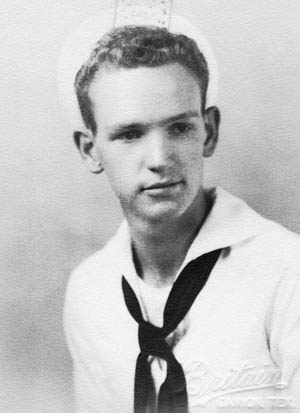
As we arrived on the flight deck, all the planes had their wings folded and were tied to the deck with cable hawsers. Working our way in serpentine fashion through the plane moorings, we came to the starboard flight deck catwalk, descended to the side, and pulled on the hatch dogs to get inside the small compartment. Closing the hatch, we then arranged ourselves to get the best possible comfortable positions in a very cramped space. The three of us dropped off immediately into slumber, content with the warmth of the preservers and our helmets for pillows.
We must have slept soundly, all huddled together, for two or three hours when suddenly the battened hatch opened. The cold gush of air was a wake-up alarm. There stood on the catwalk our chief warrant radio technician, who was as surprised as we were, packed like sardines in a can. Instinctively, we all felt we had been caught, but this old salt knew why we were there and he brushed aside our explanations, being well aware that we were the radiomen who had no bunks or compartments for off-duty and sleepless times.
He just said that we should get out on the catwalk so he would have room to check all the radio equipment strategically placed there for emergency use in combat, should the ship lose main communications. We three left for breakfast as the airedales started revving up the F4U fighter engines for take off as combat air patrol at dawn. We escaped being put on report.
An Eight-Hour Shift
Getting a leg up on the chow line since I was already in the mess hall, I finished breakfast and headed aft to a ladder, passing Omer Simms, a Fort Worth native, who was at the serving line issuing instructions to the mess cooks, one named Gayle, a 17-year-old, towheaded boy from Post, Texas. Up the ladder to the superstructure, I joined Gerry Morse, who was heading to the communications office. He yelled to me to stay out of the way of the airedales on the flight deck and double-time to the radio shack one deck above.
“Goose” Bigusiak greeted me at the hatch and pointed me to my position. Morris Perlman arose and handed me his earphones, and I slipped into his position and they placed a helmet over the phones. Goose said I was on the “Jump Fox”—code word for direct channel to CINCPAC back at Pearl. I was backup operator to Tom Kirk. For the next several hours we received many messages. Suddenly, the special secret call sign of the day ditted through my earphones and Kirk and I went to work. At one time he leaned over to see what I had typed in on the code mill and nodded his satisfaction to me. Goose stood behind us and just as we got the dah-dit-dah—“K”—indicating end of message, he spun the papers from both our mills and yelled for a Marine orderly to take the clipboard to decoding.
Tom and I both realized we had done something important, yet not what we had received in the coded message. Our eight-hour-long continuous watch was tiring. After hearing dot-dashes constantly for eight hours, you get “dit happy,” slang for radiomen who say they still hear the dah-dits after going off watch.
“LUCKY DAY MARCH 17TH NIMITZ”
Returning to my billet in the mess hall, I was determined to stay out of trouble. Having no comfort of an assigned compartment with bunk and locker, I milled about trying to look busy but sat down atop a bomb rack and was watching the bomb boys busy at work. Then an officer appeared and walked over to me. He was smiling but he said immediately that getting caught sitting would get me on report. Then I saw the gold cross on his collar and knew he was a chaplain. I tried to explain my predicament that I had just gotten off duty but had no bunk or compartment to go to. He told me to go to his office, which housed the ship’s library.
The chaplain was Grimes Weldon Gatlin, a lieutenant in the chaplain corps from Tyler, Texas, and a minister of a church there. Lieutenant Gatlin, who was nicknamed “Gats” by the crew, said I could sit in the library when off duty when it was open, and it would be okay to nap there.
He would see the captain about four of us “sparkies” who had no place to go or sleep and see if he would relent and let us “borrow” bunks in the radio gang compartment. Gats told us later the captain refused and we would just have to wait until somebody got killed. “George, don’t get caught sleeping in the library. It will get you a captain’s mast,” said Gats.

on March 19, 1945. The previous October the carrier had survived a kamikaze attack. Note the bent mast and the crewmen running for safety on the flight deck.
The gum-chewing ensign from the communications office appeared, carrying his clipboard. He nodded to Tom Kirk and me and edged his board across the desk for us to see. It said, “LUCKY DAY MARCH 17TH NIMITZ.” That was yesterday and now just old news, as the very first Navy air strike against the Japanese Home Islands was launched on that day and authorized Admirals Ralph Davison and Gerald Bogan to launch sorties carrying the new air-launched rocket called “Tiny Tim,” the prototype of the Sidewinder missile used today.
Battle Condition “Yoke Zero”
For about 36 hours we had been in battle condition “Yoke Zebra,” in which we battened down the ship’s hatches to have a watertight ship under battle conditions. The last opportunity for sleep came at a rest pause in the radio shack. I was without sleep now for more than a day and I could hardly tell a dot from a dash. Goose Bigusiak allowed me to get a nap in an area that was hidden behind the transmitters and out of the passageway. I covered up under a pile of life jackets, hidden, with my helmet being my pillow.
Upon being relieved from watch at 2400, I grabbed a sandwich made with leftovers in the mess hall and hit the hammock fully clad. At 0230 someone jerked on the hammock, telling me to get out; swinging out, I straddled a 500-pound bomb just under my hammock, not knowing it was there. Ordnance crewmen were pulling it by on a bomb cart and arming it for transport to the bomb elevator to the flight deck.
Not suspecting what was below me and in very deep slumber, not having been awakened by all the noise, I was scared out of my wits when I landed on that bomb. I yelled aloud in fear, and they got a laugh out of that. It was just like jumping out of the chute onto a big bull. I put on my helmet and went back to Radio One for safety; because of fateful misfortune that was to be my last trip within the ship. I was never to return.
When you are confined within compartments for hours and days and never see daylight or dark, you can get lost in time; looking at a bulkhead clock doesn’t help much. I adjusted just like everyone else to General Quarters and an occasional meal, little sleep, and longing for a deep sleep in my hammock.
At 0700 on March 19, 1945, I was surprised by a gum-chewing ensign (naval officer of lowest rank) who burst into the radio room shouting, “Black, your relief is just behind me. You have five minutes’ head start for breakfast and in double time, before breakfast for the crew is sounded. After chow, report to Radio Operations Room Two and relieve them there. We will be at General Quarters just before daylight.”
Behind the ensign was Morris Perlman, another radio operator who was my relief; he took my earphones. Goose yelled at Kirk and me to follow him at double time. That was the last exchange between Radioman Perlman and me. He would be killed at the radio station that I had just vacated. Why I lived and he died is beyond any explanation.
Explosion on the USS Franklin
The master-at-arms received us in a dead run. He motioned left for Goose and right for me. I refused and ducked left to follow Goose. I was just not going to get caught away from him during combat. Then the MAA jerked Kirk to go right to the forward mess hall while Goose and I went left to the after mess hall. Gayle Bowen said he was peeling spuds at the time and not in the serving line.
I think it was powdered scrambled eggs being served. I had just sat next to Goose at the mess table and shoveled in a mouthful or two when the highway to the stars appeared.
The Japanese bomb did its work at that moment. The explosion was on the starboard side and the bomb wracked the entire ship and especially the flight deck immediately above where we were sitting. More than 2,500 pieces of bomb ordnance for our airplanes was ignited by the explosion. The airplanes, gasoline, and machine-gun ammunition exploded as well at that instant.
In the mess hall, 50 sailors were having breakfast. We were thrown clear across the dining area, hitting the bulkhead and a pile of stacked sea bags and hammocks. No more stars—only a deep blackness, falling, falling into a blackened abyss.
With a few others who managed to stagger to our feet, I looked for Goose, and in the confused clamor that ensued I finally recognized him, as he had a blackened face caused by the flash of cordite. From the ladder up two decks to the hangar, a long group of sailors were in a serpentine line around all the bombers loaded and ready for combat, waiting their turn for food to be served. All of them—more than 250—instantly lost their lives. This would be made quite evident to me in a few hours.
Follow the leader. That I did. By my own count later, 13 of us headed for the portside ladder to ascend to the hangar and hence to the gallery deck on the starboard side at the very stern end of the flight deck. Omer Simms, distinguished by his white uniform and apron, headed for his portside 20mm and 40mm gun station, opened the overhead hatch to the hangar two or three inches, and slammed it shut again, saying the hangar deck was ablaze and we would have to retreat and go another way. Goose ordered the hatch from the mess shut and battened as smoke and fire was coming from there also. Trapped.
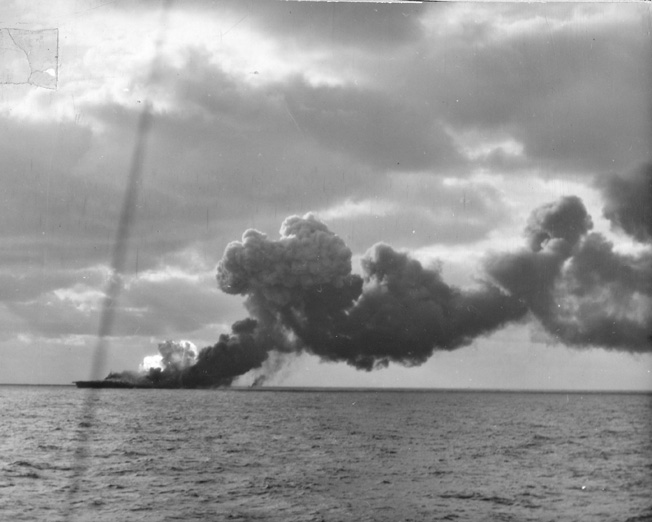
The lights were still working. The PA system blurted out GQ, but after a few notes it died away. The compartment contained six bunks, the ladder, a scuttlebutt [water fountain], and a phone. Someone in the group grabbed the phone to reach the ship’s operator and announced the phone was dead. We were very cramped in this small area. Somebody ordered us to grab towels and wet them in the scuttlebutt and also use mattress covers to cool ourselves and strain out bad air so we could breathe better. Next, two to a bunk, lie there, be still, breathe easily and quietly, and wait for help. The heavy explosions came constantly, and the really ship-shaking ones came intermittently. The scuttlebutt went dry, but the air vent was still giving us good oxygen.
Everyone was praying quietly, and we would rearrange ourselves after each bomb blast. Listing to starboard commenced, and one man opined out loud that we must have been torpedoed.
Escaping From the Gun Station
Minutes became hours. Omer was 15 years older than the rest of us teenagers, and he took charge. He checked the wheel on the overhead hatch and burned his hands––too hot to handle. Everyone was unanimous that we were heading into capsize and nobody knew that we were in there, trapped. Then another explosion occurred, this time directly over us. Smoke started pouring into the vent. So did water. Omer said we had to go up to the hangar to find a way off the ship, as we were now listing much more. The explosion was of a bomber directly over us. It ruptured air vents and also a water pipe on the hangar portside. The water cooled off the hatch.
With much effort Omer, in a very cramped space, muscled the hatch cover open to about 75 degrees and yelled for us to follow, one at a time. It now became a race in time to get 13 men out before we were consumed by smoke and asphyxiated. I started yelling the number count as each squeezed through the hatch. Four, then five, eight, nine, and I pushed number 10 through by his buttocks; 11 and then I was coughing and reeling in agony. Number 13 had on the only gas mask and could breathe better, and he motioned me up the steps and gave me a big push. I turned and grabbed him by the shoulder and pulled him clear. We were crouched together inside the burned-out body and fuselage of a simmering bomber.
There was the light of day straight across to the starboard gun mounts. The hangar deck was full of bomb holes, the flight and gallery deck had fallen in, and among all of it were the dead. I was blinded by smoke and almost stepped into a blackened hole but held up and turned another way. The top turret guns on a bomber up forward were blazing away and the ship lurched, spinning the plane around, and the .50-caliber bullets streaked across our heads, missing only by inches; we could not duck down because of debris.
Jumping Ship
A lifetime of thought swam by. By the time we reached the gun mounts and got some fresh sea air, you could not hear a thing. The heat was intense; we could now duck down for protection from shrapnel but not from the heat. Only the March wind served as a coolant. We were now slowing down, but not yet dead in the water.
Goose said that the ship would probably capsize, and in a shrill, high-pitched voice he yelled to me: “George, I can’t swim. You are on your own; decide for yourself.” I did not answer but turned to see if any of the others were going to jump, and I would take their helmet and stay with Goose. Seconds later, just forward of us, a high-octane aviation gasoline tank exploded in a swoosh. Frank Turner, an old salt from Hurst, Texas, told me in a symposium at Fort Worth College that the tank was filled with napalm.
My instincts were reversed in a microsecond. I found myself in a big leap into the water 30 feet below me without a raft, without a life jacket, without an inflatable belt, without any sort of flotation device. Big Ben was still in movement and sailed away shaking and belching and exploding and moving out of control. She was still under attack, and escort vessels were assisting with gunfire from a distance. I saw this battle from a front-row seat just like the shot-down pilot Ensign Gay did at the Battle of Midway.
I created a flotation device with my dungaree shirt, as I had been taught at Camp Wallace on Galveston Bay, and rebuttoned it up and tied the sleeves in knots; it did keep me afloat and from exhausting myself. I spotted two men, who had jumped ahead of me. They had a small inflatable flotation device thrown to them by a passing destroyer. There we were, three of us, clinging on for life. We watched until we could see no more of the fleet, only Big Ben’s smoke, which rose high in the air; then we saw nothing at all.
I did not know the two others. One was from Waco, Texas, and that is all I remember about him. He was hurt and groaning. A destroyer went by us at flank speed and turned clear of us lest they swamp us with their wave. They threw a large round “donut” in the water as they sailed past. It was just too far away for me to swim to it. The other sailor was unable to hold the Waco sailor until I got back, so the decision was to just let the donut go—too far away, too far back. Then we were all alone.
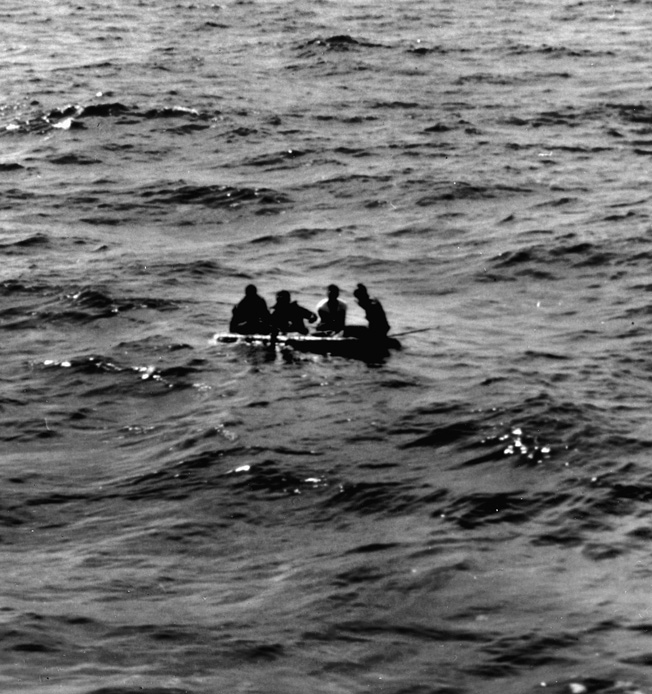
The day grew long and we drifted into swells, and they were getting fierce. The Waco sailor just could not handle those large waves. I kept telling him to hold his breath, hold his nose, close his eyes, and I would use both my arms under his armpits. He just had to keep the saltwater out. He was vomiting and gurgling, so I held on tight to him, and we went through many large waves that way. Then the third sailor told me he was dead. I said I felt movement but along came another big swell, and this time he spun around in my arms and I could see his face.
Let him go, he is done. I didn’t want to do that, but another big wave came, and when I scrambled to the surface again all I could see of him was one hand, and then he was gone. Then the two of us, at either end of the flotation device, kept afloat, each of us anchored the other at the other end. The swells did not subside, and in one of hundreds that came at us, the other sailor just did not surface, and when he let go, the float on his end rose into the air. I was now alone. The only sound was the roar of the waves, and that continued endlessly.
Rescue at Sea
Where was the Navy? Anybody out there? Nobody to hear me recite the 23rd Psalm. Nobody listening to me praying the Lord’s Prayer, the Apostle’s Creed––just talking to myself. I sang the tune “Deep in the Heart of Texas” many times. It was getting dark, or at least my vision was getting dim.
I heard a noise—a roar—above the sound of the waves, but a roar it was and it was getting louder. It was a plane, and it was headed toward me in a dive. Oh boy, if it’s a Zero, then I hope he is a bad shot, as I am just not going to dive under the water—I will never come up. He was one of ours. He began to pull up about 100 feet over me and wave his wings, dropping marker dye into the water near me, and then pulled up and disappeared. There was a good chance for me, a very good chance. Just hold on and pray.
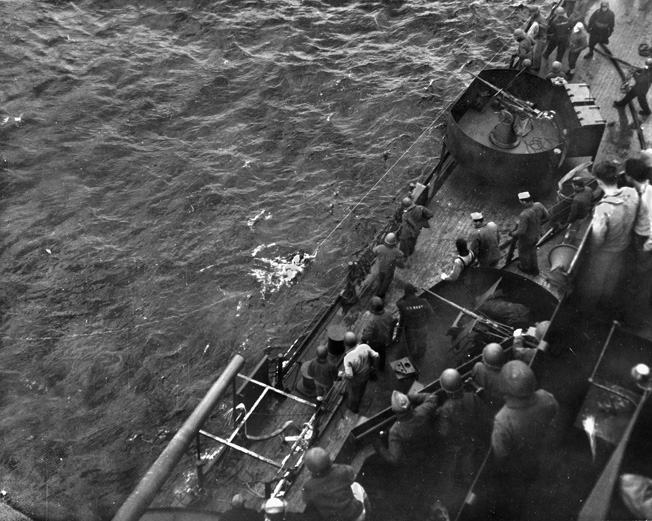
It must have been about 30 minutes later that I saw a mast appear on the horizon, it bobbed and waved and then I could see its superstructure and then its full body coming directly at me. It was a destroyer. From the forecastle a deckhand positioned a line; suddenly the ship backed her down and squatted in the water and hove to. The line was thrown accurately and fell upon me. I clutched it with all my might and wrapped a loop about my shoulders. The destroyer then moved ahead and pulled me into a cargo net amidships. I clung on for dear life, but my legs didn’t work. Two sailors came over the side and tied me in, and they heaved and I came aboard, passing under the safety line.
I was handed a coffee mug and I took a gulp of it—whiskey; it came out my nose and gagged me. And once again the highway to the stars appeared.
Saved by a Fellow Fraternity Member?
At this point in the story another unusual event took place. I had planned to write a detailed account of this event, but after a good first start I put it aside for other activities. On August 22, 2006, I received a telephone call from Rex Lovelady, who was president of my fraternity when I pledged Tau Tau Tau (now Alpha Tau Omega) in 1946.
During the rush and pledge, Rex had told me that he was a fighter pilot whose squadron was on the Enterprise and they had assisted in getting our survivors picked up and escorted us all the way back to Ulithi Atoll. We mentioned the coincidence and the matter was dropped. I last saw Rex Lovelady in Amarillo in 1951. But in 2006 he called me from his home in Shamrock, having met up with Steve Self, another fraternity brother and ex-sailor in Canyon City.
As we discussed our 55-year separation, the conversation drifted into World War II, and Rex reiterated that he had assisted in the recovery of survivors of the Franklin. I recalled our conversation of a half century earlier and, because I had commenced this writing, I had to ask him if he ever dove his plane down on a survivor and dropped his dye marker. Rex said he surely did do that. I said it could have been me, and he agreed.
Of course, we will never know, but it is a strange coincidence that while I was writing this article he was curious enough to find out what happened to me after college.
It could certainly have been Rex Lovelady who dove and dyed the water leading to my survival. I would like to say that it indeed was Rex. If it wasn’t him, it should have been.
Salty Coffee on the USS Hunt
Clang, clang, clang, all hands man their battle stations. From a deep unawareness to a split-second rousing from sleep, and being quite stirred up and revived, I bounded from my bunk, hitting the deck; my legs crumpled under me and I fell. Trying to get erect was just not possible. I was naked. Where are my clothes? Where am I?
Struggling on all fours, I attempted to find a ladder to follow the others up. I was grabbed and pushed aside and told, “All survivors stand aside; all survivors remain belowdecks.” I was knocked clear and to the deck once again. Clothes, clothes, I need clothes. A huge pile of wet clothes was in the corner. I sifted through the sea-sodden pile for my shirt. I forgot—I left it in the sea. I struggled to put on a pair of dungaree jeans. I need shoes. No shoes. Shirt I will wear, one stenciled with another name.
Now I was wringing wet and waterlogged. I need water. Whomp, whomp, 40mm guns were firing. I realized I was on a destroyer. I saw no one I knew. What do I do? Just then a destroyer sailor went through the hatch and I could see the weather deck. Then I got a glimpse of the Franklin. She was still afloat; her list was corrected. The hatch slammed shut and there I was with a lot of others, all of us confused. What do I do?
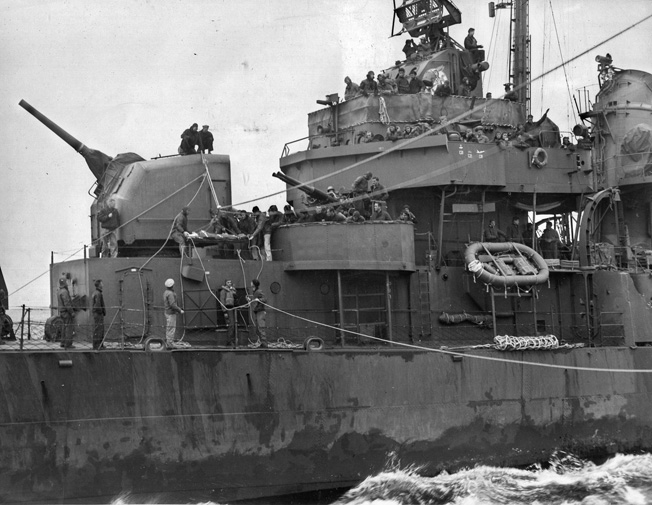
“Black, Black, come over here.” I recognized Charles Robert Campbell, Jr.—Radioman 2nd Class. I needed water. He struggled with me to the next compartment, the mess hall, and handed me a coffee mug. I gulped the first mouthful and gagged. The coffee had salt in it. I can’t drink that. Campbell tasted it and said it was pure joe. “George, drink it down.” I tried again, and it was salt. “You’re full of seawater; keep drinking and get some liquid in you.” I drank three or four salty cups of coffee. Regaining some composure, I asked where we were and what time it was. March 20 was the answer. We were on the USS Hunt, a destroyer, and we were heading south, probably back to Ulithi.
Swishing a belly full of joe, I said I was hungry. The mess cooks were at GQ but food was available. I ate a plateful, not having had a meal for more than two days. “Get back in your bunk and stay there. Don’t get in the way of the crew.” That I did. From that morning to nighttime I slept soundly, but on occasion sleep was interrupted by lots of activity. It took all day and into the night, but we managed to get away from the Japanese mainland and were now out of range.
The Only Survivor of 13
I started looking for friends. No friends were about. I started looking into everyone’s face, and I didn’t see any of the 13 who were in our group, trapped. Bigusiak was not aboard; neither was Simms the cook. Campbell said he was trapped in Radio One but got to the flight deck during all the explosions. He said a radioman from his group was in sick bay, all shot up. I knew the guy. Then the realization hit me right between the eyes. I was the only survivor of the 13 trapped in the gun station. The realization was just too much to take. I could not stop sobbing.
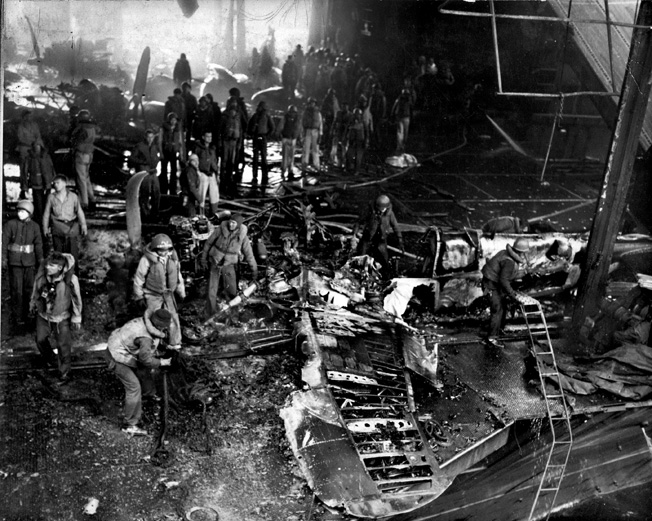
Finally, the storekeepers and laundrymen looked to our needs. My clothes were put in the dryer, and it was good to get dry and warm. I picked out a shirt with some seaman’s name stenciled on it––he didn’t claim it, he was buried from the starboard side. Campbell told me the radioman had died, and did I want to be the other sideboy with him. I said yes, but I needed shoes.
One of the destroyer men overheard and asked my shoe size. He said his would fit me and I got his dress shoes, shiny as hell. He said he had been out there 18 months with no liberty, and for me to wear them. Now that I was shod, Campbell and I went on deck and picked up the stretcher on signal. The captain held a Bible and his voice carried with the wind. We raised one end and slipped the sailor out into the water. It was a sunny, brisk day and we were nearly at flank speed encircling the Franklin as we headed south. I have lost his name in my mind after 60 years, but he was a nice and likable guy. I wrote his parents and described the sea burial, a traditional Navy ceremony.
Leaving the USS Hunt
The next day we were allowed to walk about on the weather deck. It was not like on a carrier 900 feet long; you had to have sea legs on a bucking destroyer. The Alaska, a heavy cruiser, came alongside, and there then appeared the chief warrant officer radioman, Admiral Davison’s staff radio officer. I was surprised to see him; he was going aboard the Alaska and back to the main fleet on the flagship Hancock. The transfer was to be made by breeches buoy at a fast speed. He said he had done this twice before in the Coral Sea and at Midway. An old salt, he grinned as we placed him in the buoy and strapped him in. We then sent a wounded man over who needed a doctor, because a corpsman was all we had on the Hunt.
Let me count the days. Five, I think, and the huge lagoon at Ulithi welcomed us back. The men on the Hunt bid us good-bye. I still had on someone’s shoes. A launch picked us up and we went up the gangway on the USS Grant, an Army ship manned by the Coast Guard.
I slept in; a morale officer awakened me, saying go to the weather deck for a boxing match and movies at dark. I would rather have slept. You need some R&R, sailor. It was an order. Out of the sack, up the ladder to the main deck. Quite a crowd. Jack Dempsey, a Coast Guard morale officer was going to be the referee. He was the world heavyweight champion in the 1920s and 1930s. After the match they set up a screen and projector to show us a movie, and while we were getting arranged in the twilight there was a sudden burst of light and a loud swoosh. As we looked just to port abeam of us, the USS Randolph at anchor just took a big hit from what we were told was a kamikaze, a suicide plane on a one-way mission.
(In 1980 I went aboard the USS Yorktown at the Charleston Navy Yard wearing my Franklin cap and three Randolph guys spotted me, and we had quite a gabfest. All three recalled this incident I saw and said they had several casualties over it.)
It was announced that all Franklin personnel would disembark to the USS Oneida.
We were going back to Pearl.
Taking On Survivors From Iwo Jima
“Now hear this. All Franklin personnel will transfer from the portside by gig to the Oneida commencing at 0800. All sea bags and gear will be carried by the owner to the weather deck for unloading.” A sailor near me mused, “What the hell are they talking about? Gear? What gear? I ain’t got no gear.” Very funny. All I could do was laugh at myself. There I was wearing dungarees that didn’t fit and a dead sailor’s shirt—no socks—but a pair of dress shoes so shiny that you could use them for a mirror and comb your hair—but no comb.
My face full of freckles was now a face full of blisters and scabs. My first- and second-degree facial flash burns were healing. My glasses were gone so I struggled with myopia. The hypothermia and dehydration reduced my weight to about 120. I had trouble hearing—everything had a ring to it. Combat fatigue—you betcha; about all of us had it. Other than that I was just fine.
The sight of wounded men was just beginning to materialize. Iwo Jima, after six weeks of heavy fighting, had been secured. Remnants of the badly wounded were being gangplanked over to the Oneida. Scores of them were coming aboard in a steady stream. Each and every one was wrapped with gauze bandages, sometimes from head to foot. Sometimes you saw one with his head uncovered and you just gazed at the situation in silence. These were U.S. Marines, what was left of them, and they were going home. They were a bunch of teenagers just like the rest of us and they were carried gingerly, one by one, to the massive sick bay, which was quickly filled. Yessir, folks, I would have taken off my hat, if I’d had one, to the golden Marines.
Gerry Morse
Anchor aweigh, and the rest of us were stuffed like sardines into the sleeping compartments belowdecks, mine being two decks below the water line. What do you know—I ran into Gerry Morse from the communications office and we buddied up together, which lasted until the end of the war.
It was March 20-something, 1945. As we got to sea it was announced that Iwo Jima was over and the island was ours. We noticed strange-looking ships acting as escort for several hospital ships. Gerry and I identified them as British from their flags. There was an aircraft carrier serving as submarine defense. The war in Europe had Allied armies nearing Berlin, and the British Fleet had emerged in the Pacific to finish off the war. The HMS Illustrious was identified as our escort and protector. She was too slow for our fast attack carriers but most valuable in submarine warfare, and her planes were deadly and expert in killing subs.
We had been three days at sea and were now in the backwaters of the war between the ports of Ennui and Monotony, or so we thought. Gerry and I were sitting in my bunk below the water line. An interruption of a sense of sound, an arousing sensation or vibration—we sensed an explosion. In a microsecond we were up the ladder to the next deck bunking level in a dead run; the guys there couldn’t understand why we were in double time (they were above sea level) and onward to the next level, the weather deck, and through an open hatch.
Gerry turned forward, and I followed in hot pursuit. We got to the portside gun deck and General Quarters blew. We had the canvas off and a magazine out and in place. Gerry loaded and I put myself in the shoulder grooves in firing position. I would have fired at anything that moved. Some minutes went by, and I had full movement of the gun and was ready. It turned out to be a submarine attack rather than aerial. The backwater Navy gunners arrived and told us to secure from the gun mounts and get below. I kept my eye on the open waters, and Gerry opened up on them saying, “Where have you guys been? You’re late here and supposed to be protecting us.” They had a cavalier attitude and seemed uncaring. A gunnery officer appeared and ordered Gerry and me below, and some harsh words were exchanged.
Gerry headed below, but we passed the sick bay and the hatch was locked in an open position, and in he went with me at his heels. These poor Marines were panicky. There they were, blinded and bound bedfast in all shapes and fashions and completely helpless. There was not a single medical corpsman in the entire ward. Gerry went from bed to bed saying comforting words, and I started emulating him. After a few minutes some medics did appear, and I think we had them settled down. One Marine was trying to get out of bed with a leg elevated almost to the overhead. Gerry grudgingly turned the matter over to the latecomers and we headed below.
Secure from GQ. Some time later we were informed that the British fleet killed the Jap sub. But this incident did not end the excitement on board of the backwater Navy.
We were in the mess hall during mess. I never did find out what it really was, but a steam cooker of some sort in the galley got too much pressure, and it blew out with a pretty good bang. I was positioned nearest one of the hatches and nearly got trampled trying to get out of the way. I did get hit in the shoulder so I jumped into the corner and let the entire mess area evacuate. As I was nearly one of the last ones out, a big fat cook muscled me and yelled, “Why is everyone running away? Come and help!” I looked at him incredulously with the thought that he simply did not understand what was going on. He was ignorant of the beating everyone had taken, and news of the Franklin was top secret then and for another two months.
Arriving in Hawaii
The blue haze to the port side came into view, and Gerry and I figured out it was Barbers Point on Oahu. Not too long after that, our guess was confirmed when Diamond Head became clearly visible. We were nearing the net area leading into Pearl, and into the channel we went. Our ship had first entry requirements, as it needed to offload all the wounded. Orders to stay at our bunks were issued to keep clear the main weather deck to handle a very long line down the gangway.
Troop carriers formed a convoy, and scores of Franklin survivors were delivered to the Aiea receiving station and placed in long lines. The word got out and the area quickly filled with gawkers and curiosity seekers. Of all places, several radio-school sailors in the class behind me had just arrived from stateside, and I must say all of us were quite a spectacle of ill and thinly clad (now war veteran) sailors.
One of our officers arrived and informed us we were on R&R for several weeks and would be placed FFT (for further transfer) awaiting delivery of our personnel files. Food and sleep and rest—man, show me my bunk. Movies tonight. I was not interested in any movie. Well, this one was a Navy war movie fresh out from Hollywood. Gerry was being insistent that I go. It was open air with a big screen and hundreds of guys sitting on bleachers. It was one of those “buy war bonds” films, full of patriotism and even more full of just plain old propaganda. When our ships opened fire and the hero did a special stand up in the face of the enemy, something stirred suddenly just next to me. A sailor I did not know took his shoes off, stood up, and threw both shoes into the screen. Well, that interrupted things, and the Shore Patrol arrived and bodily threw him into a van truck. I don’t think he was taken to the brig; what was needed was the psycho section in the sick bay. The word got around (scuttlebutt, we call it) that some were taken out of our ranks and we were never to see them again.
One of the four radiomen who slept in hammocks in the after mess hall was R.L. Tipton of Fort Worth, Texas. “Tip” was not on the starboard watch but was assigned port. We had been in the 50th graduating class at the Naval Armory in Indianapolis, and he had shared experiences with the other three, me, Martin, and Ellis. I learned that he was one of the badly wounded and was in the hospital at Aiea, which was nearby. As I recall, Gerry Morse and I got permission to go see him, and we boarded a bus to make the trip. Tip was in a large group of those with multiple wounds and when we located his bed it was hard to identify him, as his legs were casted and elevated and his torso and head were heavily bandaged. Though he was glad to see us, Tip was exhausted and in pain. He was scheduled to be shipped out with a large group of sailors and Marines.
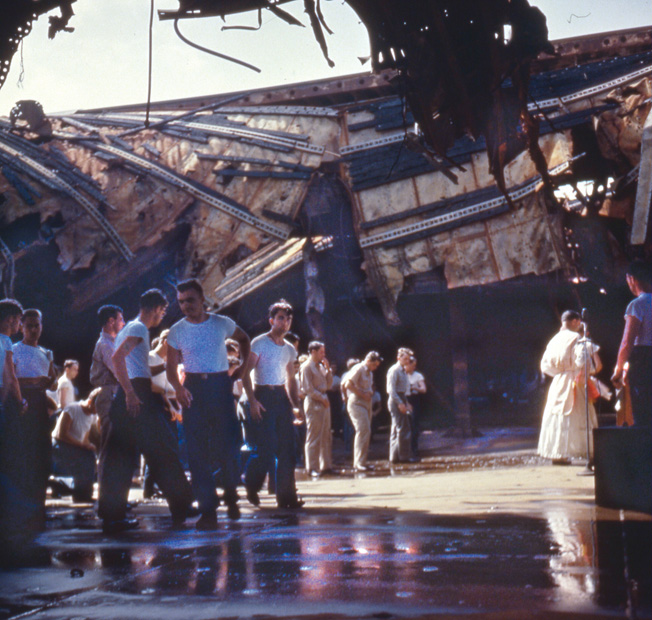
The news was out about the first main landings on Okinawa, and we all mused that our Task Group 58 was the vanguard and we took the first hits. Nurses broke into the conversation telling us we had stayed our time limit, so we left. I recall turning back to face Tip, gave him a salute and a smile. I never saw him again.
I recall that about 11 badly wounded expired and were buried in the National Cemetery on the mountainside of Oahu in an ancient volcano crater called “the Punch Bowl.” In the 1980s I went back to Pearl and on up into the Pali to see these guys. The Bureau of Burials had names of those buried there, of course, but there was no designation of any Franklin sailors. Wandering all over the rows of white crosses, I did stumble onto one that was Ernie Pyle, who was buried there, having been killed on Ia Shima. He was the serviceman’s newspaper reporter and got into the trenches where the action was to get his story.
Next was the delivery of a Navy quartermaster purchase order. I had lost everything. Fitted with new glasses and a full sea bag of clothing and equipment, I was detailed by jeep over to Ford Island Naval Air Station and given my orders to report to a new assignment on Maui, a unit kept in secrecy called NACTU (PAC), which was the abbreviation for Night Attack Combat Training Unit.
I slung my sea bag and hammock into the bomb bay of a Douglas dive-bomber and took to the air, flying over the islands of beautiful Hawaii. Farewell to Pearl.
Epilogue
George Black remained in Hawaii for several more months where he trained in radar and on a top-secret direction finder. The war ended on September 2, 1945, when the Japanese, reeling from the atomic bombing of Hiroshima and Nagasaki, signed the articles of surrender.
Although she was repaired and sent back to sea, the USS Franklin, like so many heroic ships, reached an inglorious end. She was decommissioned in 1947 and sold for scrap in 1966.
Shortly before his discharge from the Navy (including a brief stint aboard the USS Zuni, ATF-95—a Navajo-class fleet tug), Black recalled an incident at the discharge center that showed how emotionally fragile he was from his combat experiences:
“About 50 sailors in our group were sent on but a few of us were retained for other matters. None of us had signed on to join the reserves. The room darkened and a Technicolor movie about the Navy, patriotism, and wartime propaganda filled the screen and then one big battle scene appeared. The film was about the Franklin in all its glory and gore. My brain snapped and a cold sweat broke out. I was having flashbacks after seeing the real thing.
“I just was completely caught off balance and lost it. When the lights came on I was the center of attention. I was the only spectator not signing up for the reserves. Being separated from the rest, I was sent to sick bay and was interviewed by one of the doctors. I figured out he was a shrink who was asking me a lot of questions.
“I finally gave him a straight answer that I did not appreciate being blindsided by a combat film that included me and a lot of my dead friends. Though he was trying to help, I was being evasive now. I just wanted to go home. He paused and stared at me, and I think he was making a diagnosis. Finally, he accepted my reasoning for the very embarrassing episode I had made and signed my medical papers. I would have done or said anything to keep from being deprived of my train ride home. It was a mistake that caused me untold anguish for another 10 years for concealing my emotions. A big black dog had climbed up my back.
“It seems I am always at the forefront of menacing situations and always seek to escape when confronted by overwhelming odds. When at peril on the sea, Saint Elmo, our patron saint, always intercedes and I stand back blindly, completely consumed by another harrowing escape. Not a hero, just there as a witness, an expert in survivorship.” n
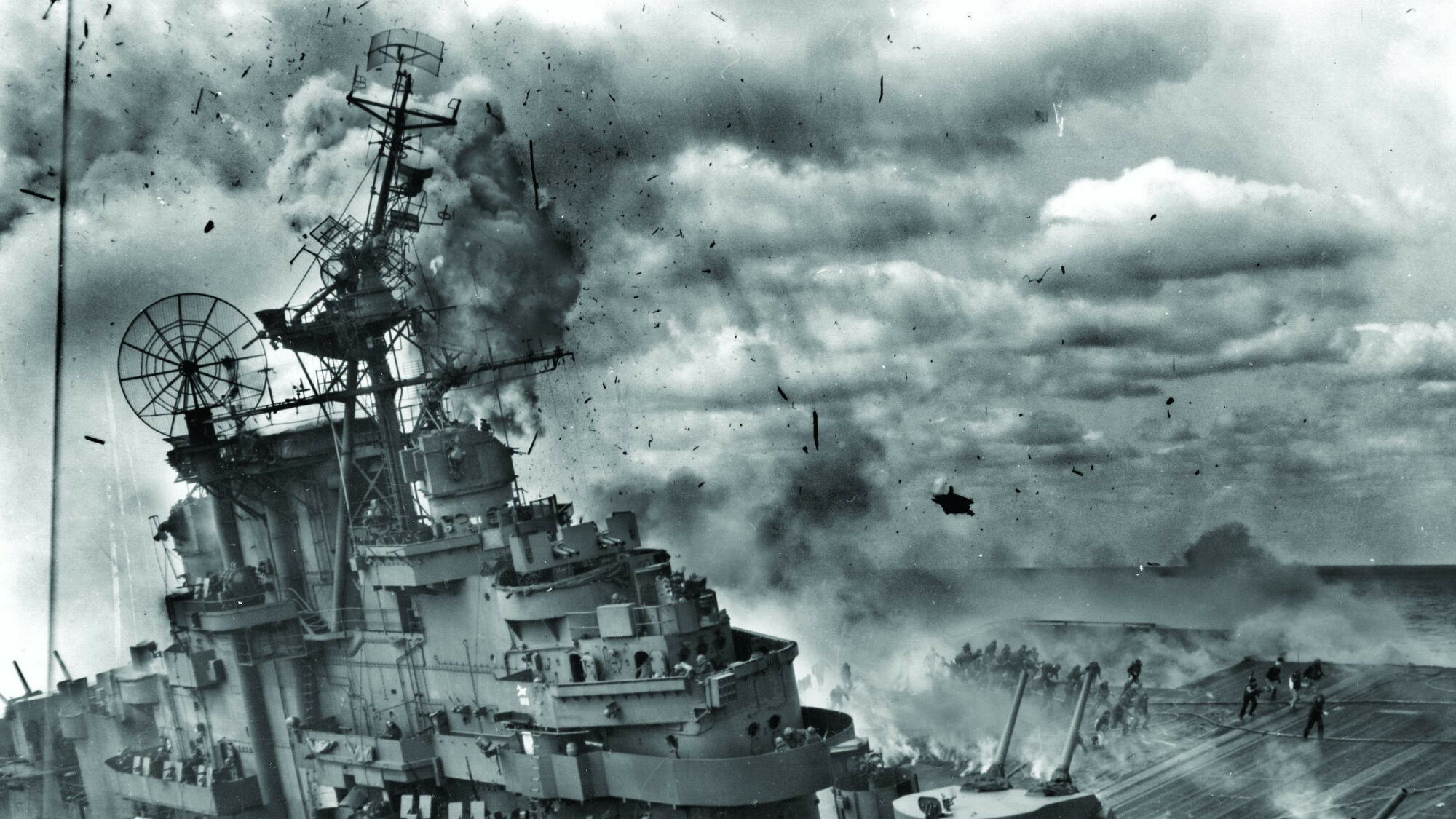
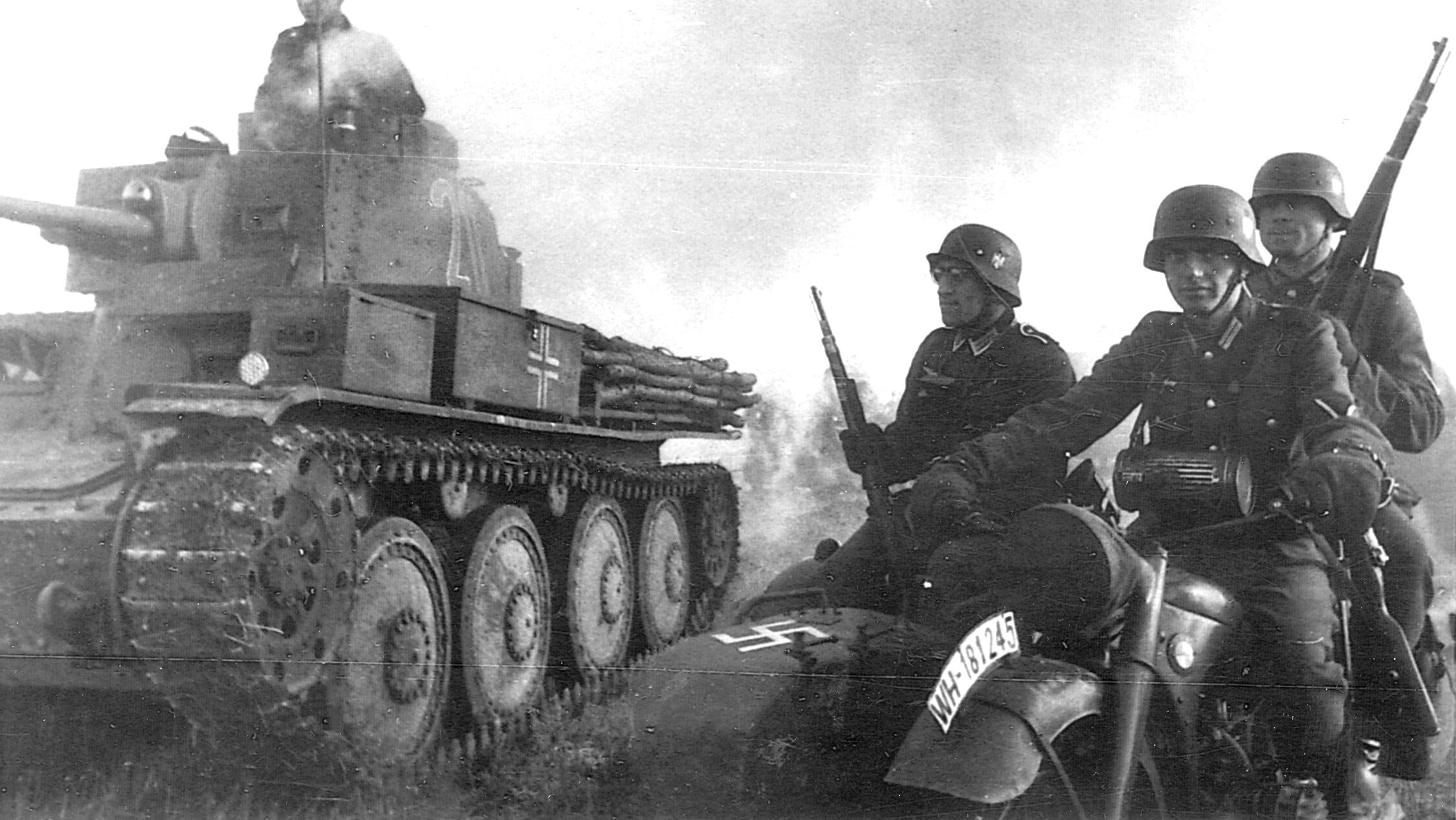
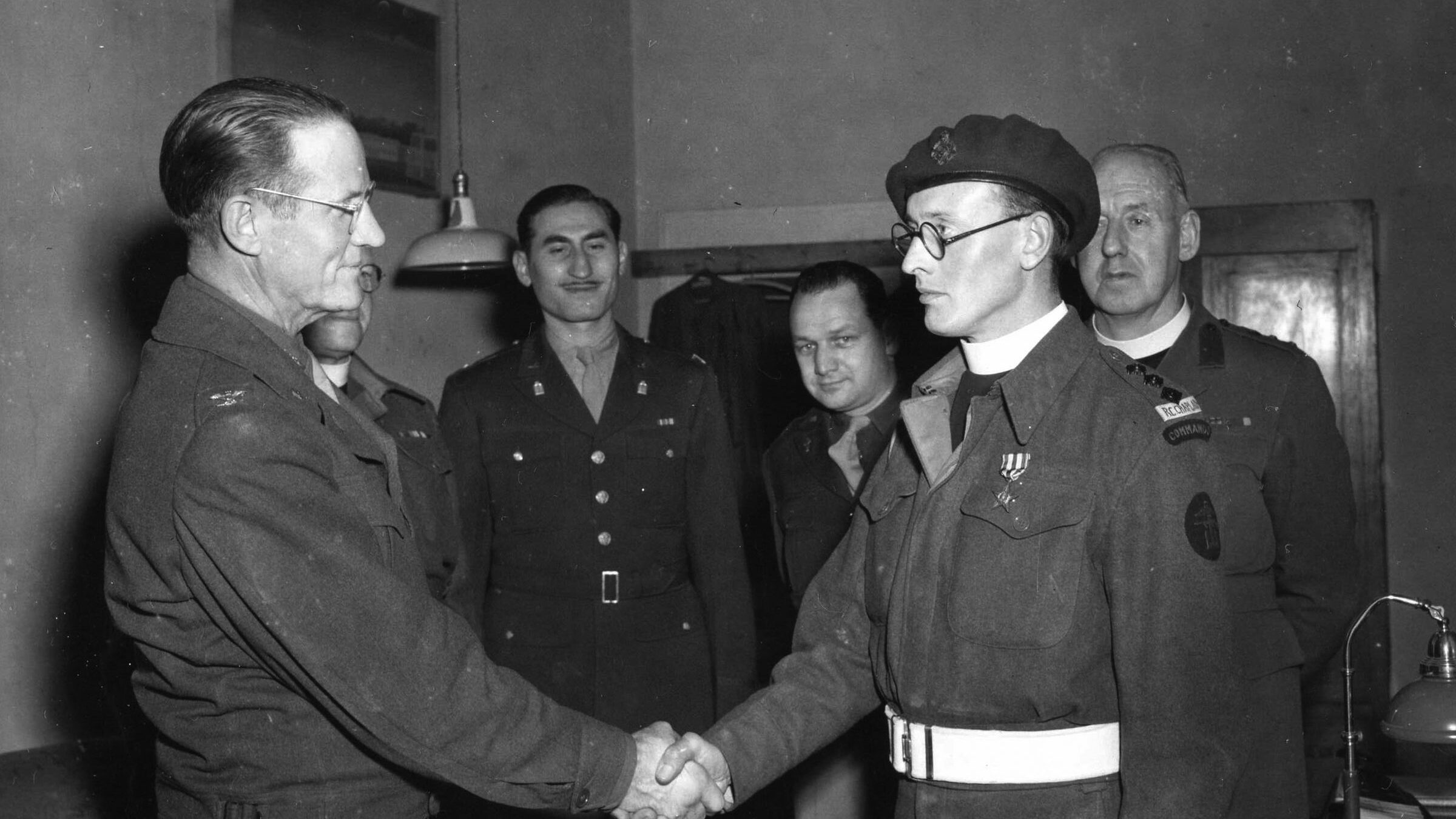
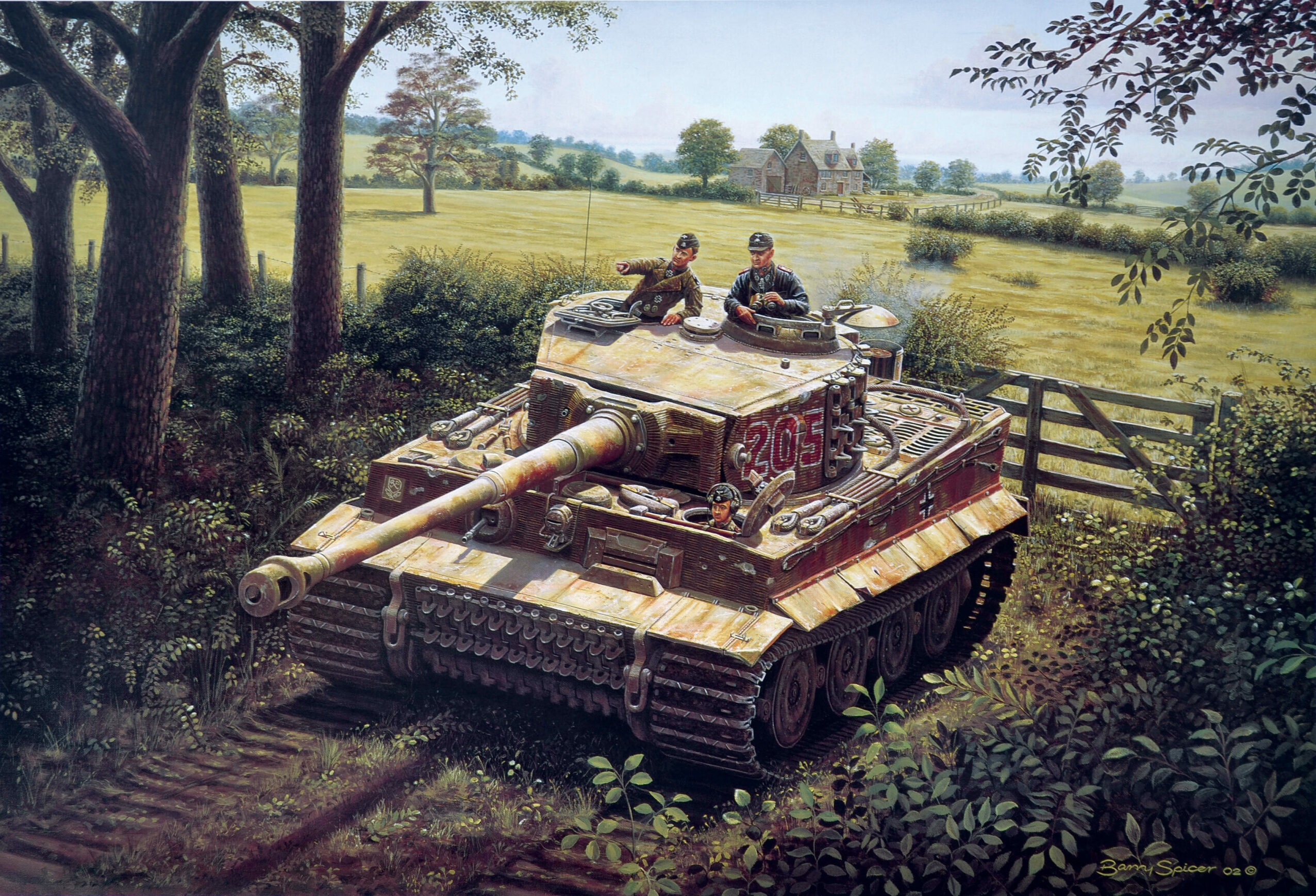
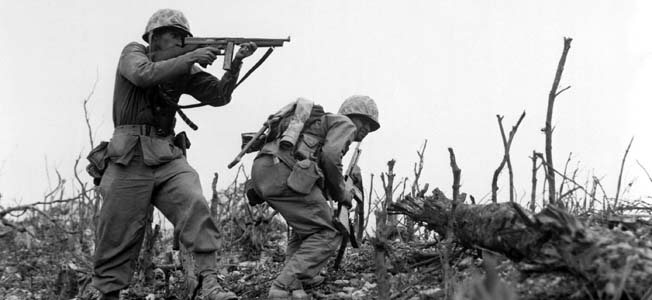
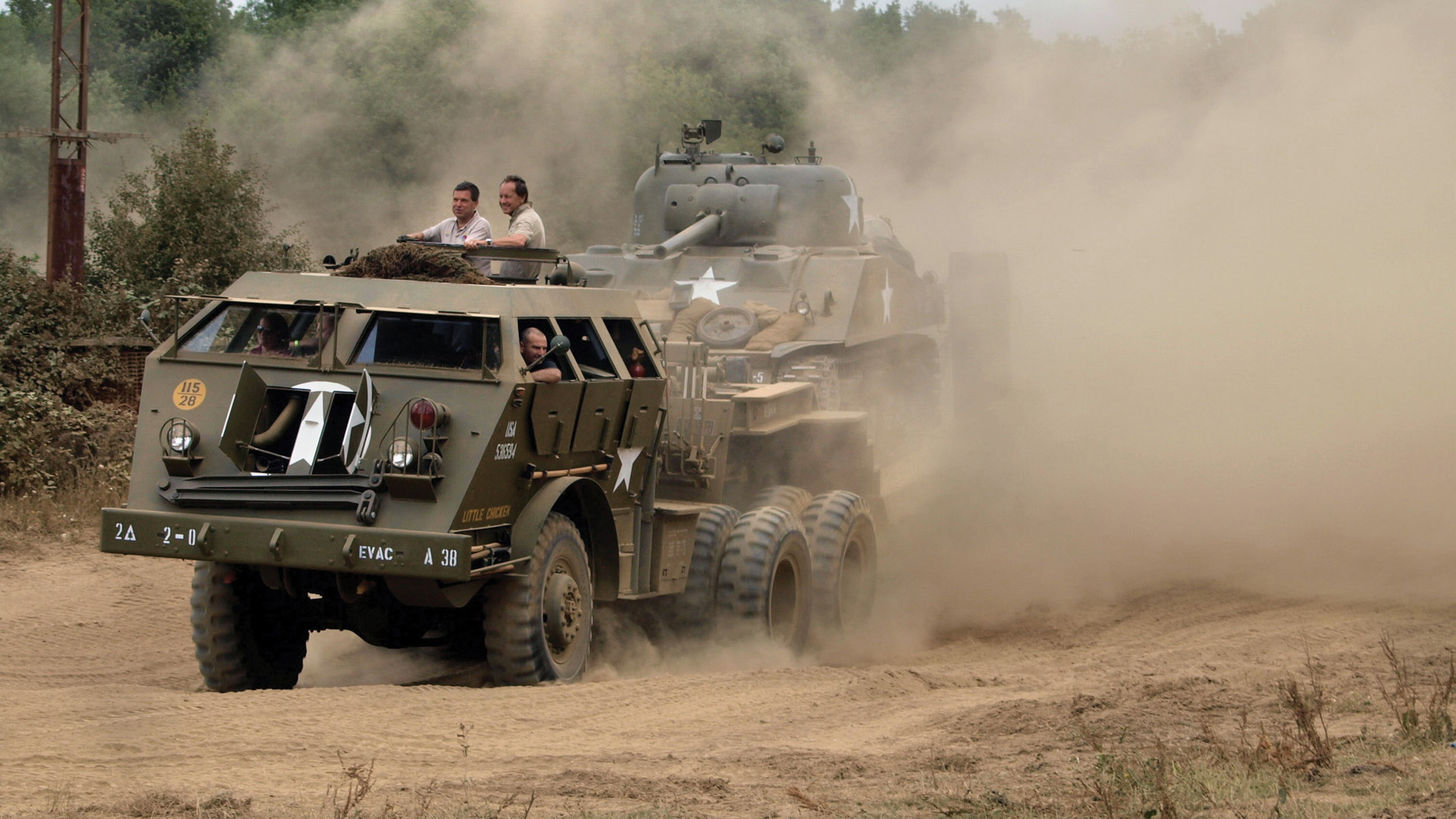
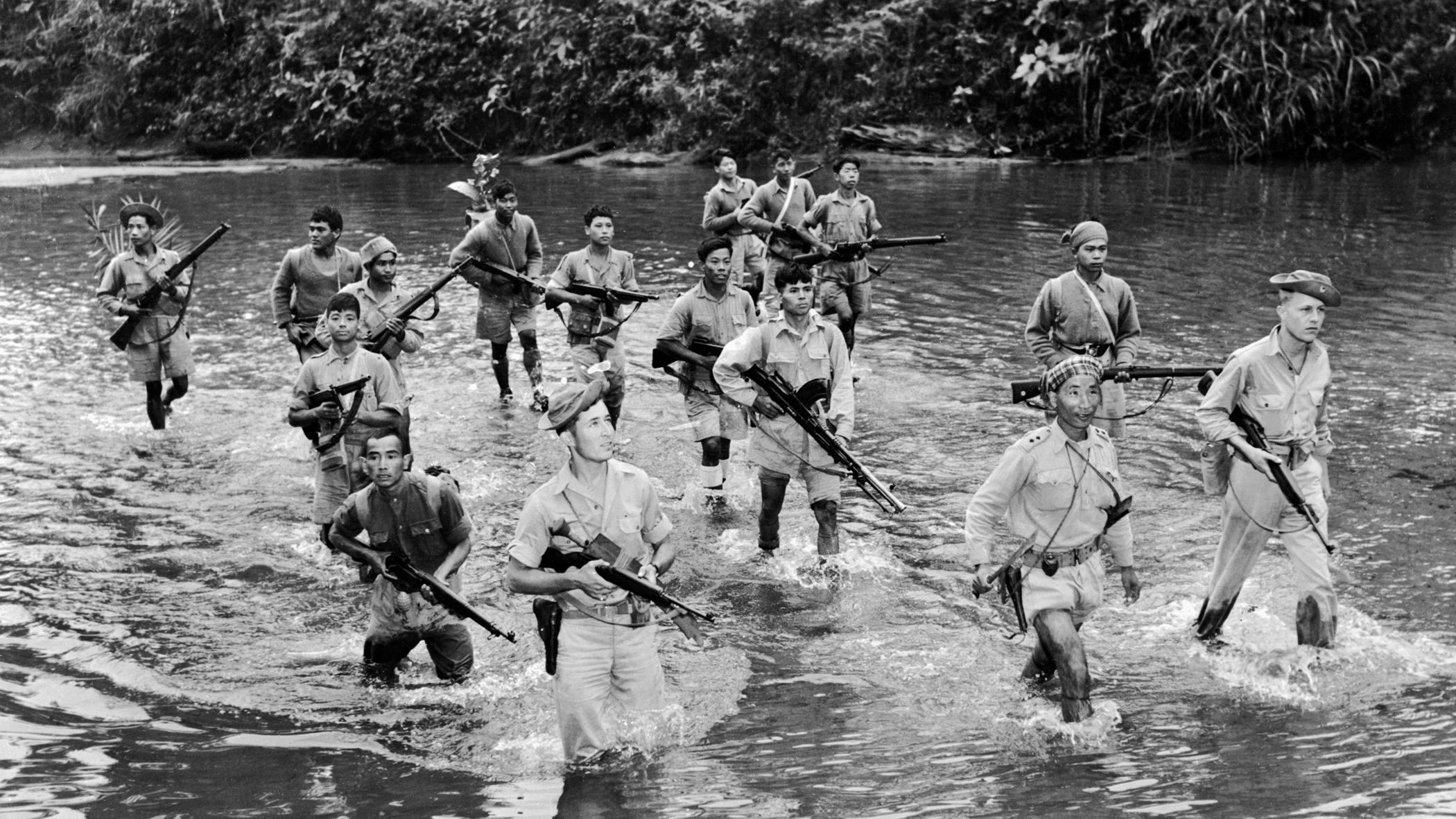
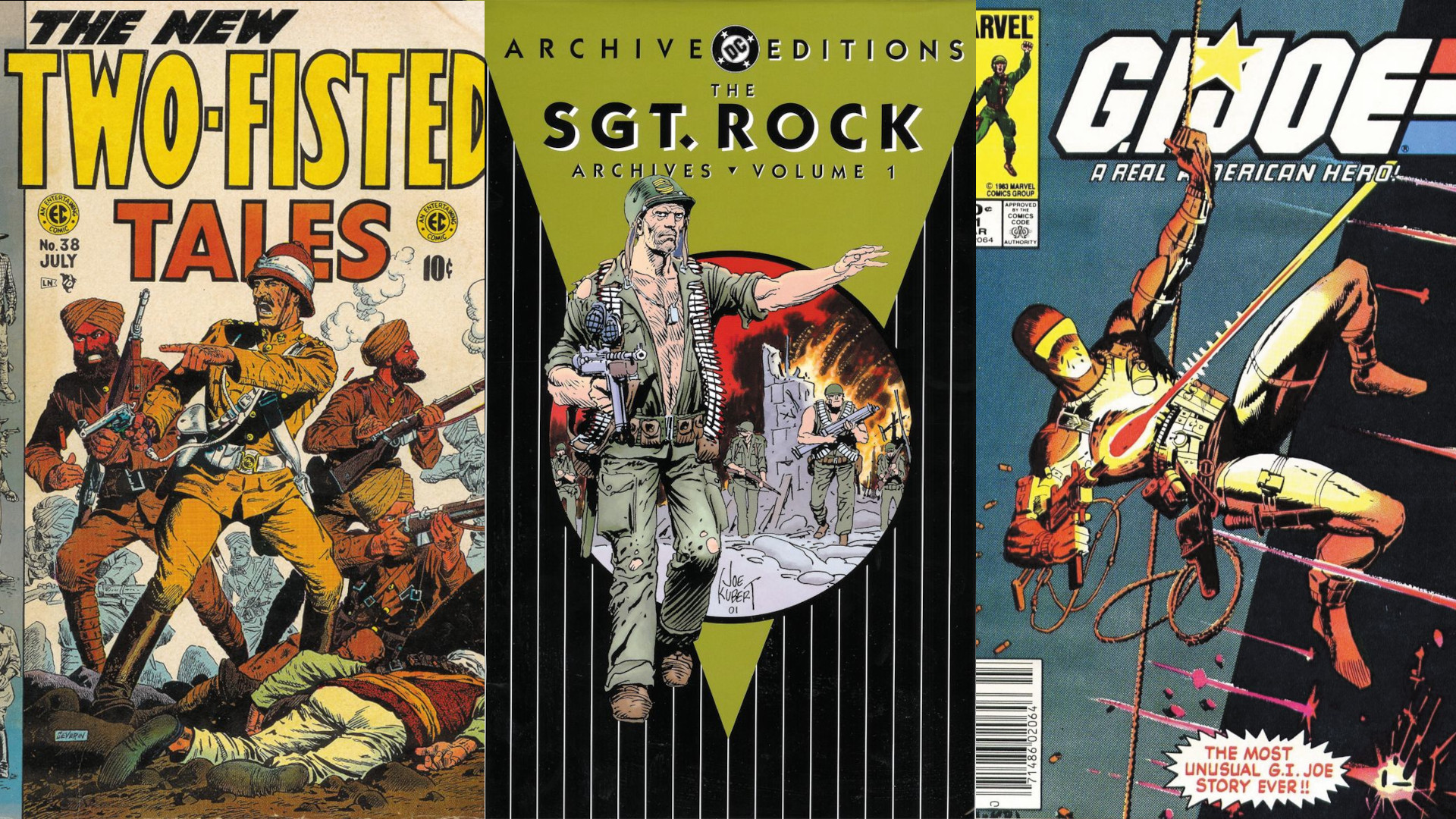
Join The Conversation
Comments
View All Comments